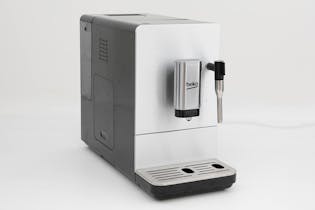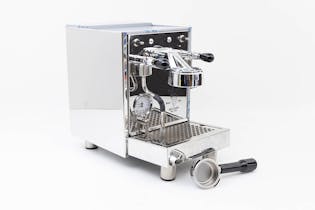Espresso coffee machines
Find the best espresso machine for your home with our buying guide and test results for 68 current and 55 discontinued models.
Which type of machine suits you? Here are the pros and cons of each, plus features to look for.
Types of espresso coffee machines
Manual and semi-automatic machines

Manual and semi-automatic espresso machines work similarly to one another. Some have a built-in grinder and others don’t. Either way, you pack ground coffee into a filter basket that sits in the portafilter, then twist the portafilter into the machine’s group head.
Manual machines require you to judge the amount of water that flows through the filter basket, while semi-autos cut off the flow automatically.
Typically, you’ll manually froth your milk, but some semi-autos offer automatic milk frothing.
- Usually make a very good tasting brew – the strength can be varied by adjusting the amount of coffee and water used
- Most are very good at frothing milk
- Take longer to master than automatic and capsule machines
- Portafilters and filter baskets can be fiddly to use and clean
Automatic machines

Automatic and automatic-manual espresso machines (also known as “super automatic”) automatically grind the coffee, tamp it, and extract the espresso shot.
Many have an integrated milk frother, but some have a steam wand for manual frothing.
- Most make a very good tasting brew
- Easy to use
- Built-in grinder
- Some models can use both whole beans and pre-ground coffee
- Digital displays and indicators
- Less control over strength and flavour than a manual or semi-automatic machine
- Can be more expensive than other machine types
Capsule machines

Capsule machines use airtight pods (capsules) of coffee. You typically insert the capsule, pull a lever and flick a switch. The machine pierces the capsule and forces hot water through.
Learn more about coffee capsules.
- Easy to use and clean
- Sealed coffee capsules can stay fresh for up to 9 months
- Most deliver coffee very quickly
- Usually smaller than other machine types
- Often cheaper up front than other machine types
- Less control over the strength of your brew compared to other machines
- Taste often not as good as other machine types
- Capsules cost more than ground coffee, so the ongoing costs are higher
- The packaging from single-use capsules creates extra waste – reusable ones get around this but you’ll lose some of the convenience of a capsule machine
- Proprietary systems keep you tied in to using certain brands of capsules
- Some models don’t have a milk frother
Espresso machine features to consider
Ask whether there's a demonstration model of the machine you’re interested in so you can try before you buy, and look for these features:
Brew capacity: If you’ll want to make two coffees at once, make sure the machine you’re considering can do so. Also check whether it can accommodate tall cups as not all models can.
Size: Compact machines leave you with more bench space but, if you often make several coffees back-to-back, you might need a larger machine with a water tank that won’t need refilling so often.
Adjustable grinder: If the machine you’re considering has a grinder, make sure it’s adjustable so you can grind your coffee by the right amount to suit your taste.
Adjustable strength setting: If you buy an automatic machine, choose one with an adjustable strength setting so you can tweak the intensity of the brew to your taste.
Milk frother: If you want full control over milk frothing, choose a machine with a manual steam wand. Some automatic milk frothers also do a great job, including some capsule machines that use milk capsules. Check the milk frothing scores in our test results.
Controls: Make sure they’re clear and simple to use. Digital displays are usually best.
Tamper: Choose a machine with a separate, solid metal tamper to pack the coffee down evenly so it extracts evenly. Plastic tampers and those fixed to a machine typically do a poor job.
Cup warmer: Using a machine’s cup warmer is the easiest way to prevent a tepid brew and preserve its flavour and the milk’s froth. If the machine doesn’t have one, you’ll have to pre-heat your cup separately.
Cleaning programme: Ideally, any machine you buy will have an automatic cleaning programme. If the machine has to be cleaned manually, check that the parts can be removed easily and are dishwasher safe.
Drip tray: A large drip tray won’t need draining as often as a smaller one, which is handy if you make regular coffees throughout the day. Make sure it’s easy to remove.
Exterior: A seamless exterior is easiest to clean. But note that stainless steel and matte finishes can make fingerprints and grime stand out.
See our espresso machines test results to find a machine with the features you want.
Coffee machine costs – up front versus long term
Capsule machines are often the cheapest type to buy. But they can mean spending more long term, as capsules typically cost more than ground coffee or whole beans.
Here's how coffee costs compare over a year, based on two double shot espressos a day:
- Espresso machines: $360–$945 per year.
- Capsule machines: $950–$1,505 per year.
- Takeaway coffees: $2,900–$4,015 per year.
* Excludes the price of the coffee machine, since there’s a wide range in prices. Check out our test results to compare prices.
Buying a secondhand espresso machine
Under the Electricity Act, all electrical appliances for sale must be safe, whether they're new or secondhand, bought privately or from a dealer.
You might save money buying secondhand, but there are some things to check before you hand over your cash:
Type of machine: Consider the pros and cons of the different types. Some are easier to use while others provide more control. And some may be cheaper up front but can cost you more over time.
Brand and model: Check our espresso machines test results for both current and discontinued models to see how the machine performed in testing. Our discontinued models go back several years. If the model you’re looking at was widely available when it entered the New Zealand market, there’s a good chance we’ve tested it. Also check the brand’s reliability and satisfaction ratings for espresso machines.
Features and settings: Check whether the machine has the features and settings you want. See our test results to compare models.
-
Condition, age and usage: Does the machine look clean and tidy? Check the exterior and all components for cracks, dings or excessive scratches. Also look for coffee stains and other grime, which can be a sign of infrequent cleaning. Such grime can taint the flavour of your coffee and even lead to blockages that damage the machine.
Ask the seller how old the machine is and how often it’s been used. Have they owned it from new? Has it ever been used commercially?
Cleaning, maintenance and repair history: Ask whether the machine has been cleaned regularly and descaled as needed. Have any major repairs been required?
Price and guarantee: Compare the asking price with the prices of similar espresso machines on the market. Don’t be afraid to negotiate. Note: If you buy from a secondhand dealer, you're protected by the Consumer Guarantees Act. If you buy privately, you're not – but you might find cheaper deals.
Test run: Request a test run before buying the machine. Make three or more cups of coffee using your usual coffee and milk. Does the machine warm up quickly for first use? Check you can easily use the machine. Make sure the coffee grinds evenly (ie, the grinder’s burrs are sharp). Check for any leaks. Also make sure every cup of coffee tastes good and the strength is consistent.
We've tested 123 espresso coffee machines.
Find the right one for you.
Beko

Breville
.JPG&w=315&q=75)



